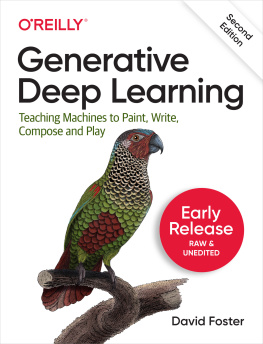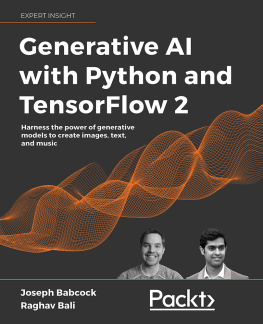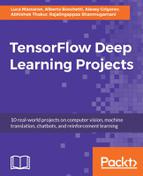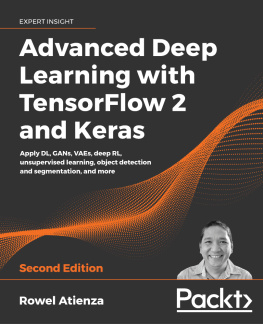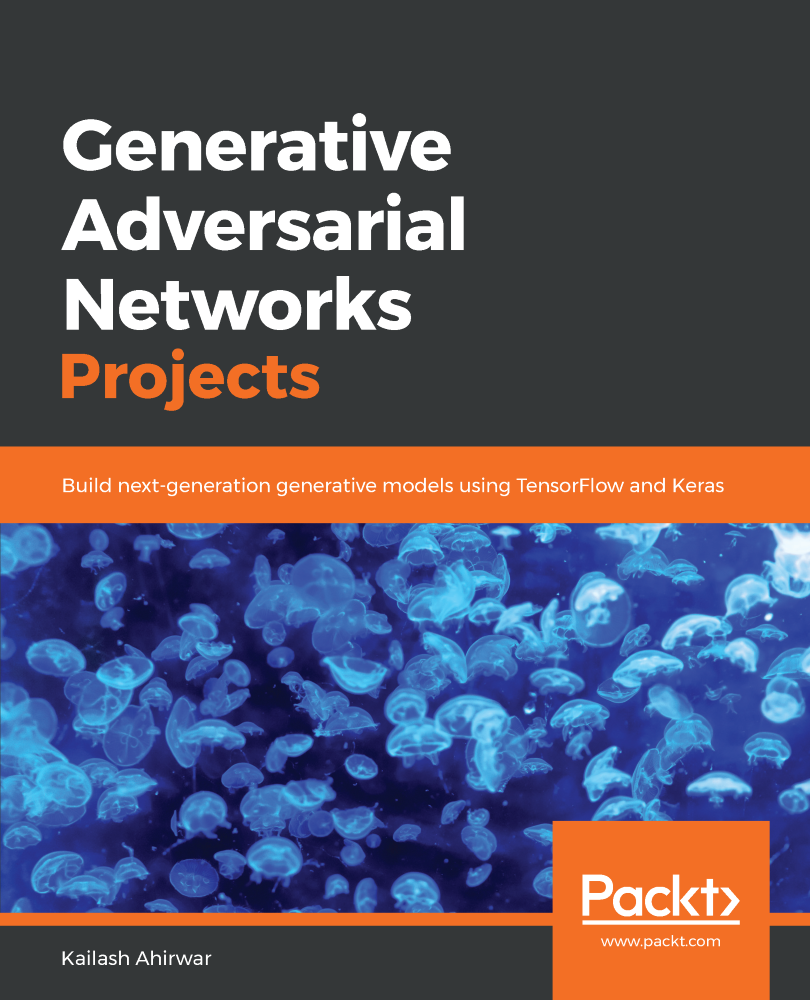
Generative Adversarial Networks Projects
Build next-generation generative models using TensorFlow and Keras
Kailash Ahirwar

BIRMINGHAM - MUMBAI
Generative Adversarial Networks Projects
Copyright 2019 Packt Publishing
All rights reserved. No part of this book may be reproduced, stored in a retrieval system, or transmitted in any form or by any means, without the prior written permission of the publisher, except in the case of brief quotations embedded in critical articles or reviews.
Every effort has been made in the preparation of this book to ensure the accuracy of the information presented. However, the information contained in this book is sold without warranty, either express or implied. Neither the author, nor Packt Publishing or its dealers and distributors, will be held liable for any damages caused or alleged to have been caused directly or indirectly by this book.
Packt Publishing has endeavored to provide trademark information about all of the companies and products mentioned in this book by the appropriate use of capitals. However, Packt Publishing cannot guarantee the accuracy of this information.
Commissioning Editor: Sunith Shetty
Acquisition Editor: Aman Singh
Content Development Editor: Snehal Kolte
Technical Editor: Dharmendra Yadav
Copy Editor: Safis Editing
Language Support Editor : Mary McGowan
Project Coordinator: Manthan Patel
Proofreader: Safis Editing
Indexer: Mariammal Chettiyar
Graphics: Jisha Chirayil
Production Coordinator: Shraddha Falebhai
First published: January 2019
Production reference: 1310119
Published by Packt Publishing Ltd.
Livery Place
35 Livery Street
Birmingham
B3 2PB, UK.
ISBN 978-1-78913-667-8
www.packtpub.com
mapt.io
Mapt is an online digital library that gives you full access to over 5,000 books and videos, as well as industry leading tools to help you plan your personal development and advance your career. For more information, please visit our website.
Why subscribe?
Spend less time learning and more time coding with practical eBooks and Videos from over 4,000 industry professionals
Improve your learning with Skill Plans built especially for you
Get a free eBook or video every month
Mapt is fully searchable
Copy and paste, print, and bookmark content
Packt.com
Did you know that Packt offers eBook versions of every book published, with PDF and ePub files available? You can upgrade to the eBook version at www.packt.com and as a print book customer, you are entitled to a discount on the eBook copy. Get in touch with us at customercare@packtpub.com for more details.
At www.packt.com , you can also read a collection of free technical articles, sign up for a range of free newsletters, and receive exclusive discounts and offers on Packt books and eBooks.
Contributors
About the author
Kailash Ahirwar is a machine learning and deep learning enthusiast. He has worked in many areas of Artificial Intelligence (AI), ranging from natural language processing and computer vision to generative modeling using GANs. He is a co-founder and CTO of Mate Labs. He uses GANs to build different models, such as turning paintings into photos and controlling deep image synthesis with texture patches.
He is super optimistic about AGI and believes that AI is going to be the workhorse of human evolution.
This book wouldn't have been possible without the help of my family. They supported me and encouraged me during this journey. I would like to thank Rahul Vishwakarma and the whole team at Mate Labs for their support. Also, a big thanks to Ruby Mohan, Neethu Daniel, Abhishek Kumar, Tanay Agarwal, Amara Anand Kumar, and others for their valuable inputs.
About the reviewer
Jalaj Thanaki is an experienced data scientist with a demonstrated history of working in the information technology, publishing, and finance industries. She is author of Python Natural Language Processing and Machine Learning Solutions, by Packt Publishing.
Her research interest lies in natural language processing, machine learning, deep learning, and big data analytics. Besides being a data scientist, Jalaj is also a social activist, traveler, and nature lover.
Packt is searching for authors like you
If you're interested in becoming an author for Packt, please visit authors.packtpub.com and apply today. We have worked with thousands of developers and tech professionals, just like you, to help them share their insight with the global tech community. You can make a general application, apply for a specific hot topic that we are recruiting an author for, or submit your own idea.
Preface
Generative Adversarial Networks (GANs) have the potential to build next-generation models, as they can mimic any distribution of data. Major research and development work is being undertaken in this field because it is one of the most rapidly growing areas of machine learning (ML). This book will test unsupervised techniques of training neural networks as you build eight end-to-end projects in the GAN domain.
Generative Adversarial Network Projects begins by covering the concepts, tools, and libraries that you will use to build efficient projects. You will also use a variety of datasets in the different projects in the book. With every chapter, the level of complexity and operations advances, helping you get to grips with the GAN domain.
You will cover popular approaches such as 3D-GAN, DCGAN, StackGAN, and CycleGAN, and you'll understand the architecture and functioning of generative models through their practical implementation.
By the end of this book, you will be ready to build, train, and optimize your own end-to-end GAN models at work or in your projects.
Who this book is for
If you're a data scientist, ML developer, deep learning practitioner, or AI enthusiast looking for a project guide to test your knowledge and expertise in building real-world GANs models, this book is for you.
What this book covers
, Introduction to Generative Adversarial Networks , starts with the concepts of GANs. Readers will learn what a discriminator is, what a generator is, and what Game Theory is. The next few topics will cover the architecture of a generator, the architecture of a discriminator, objective functions for generators and discriminators, training algorithms for GANs, KullbackLeibler and JensenShannon Divergence, evaluation matrices for GANs, different problems with GANs, the problems of vanishing and exploding gradients, Nash equilibrium, batch normalization, and regularization in GANs.
Next page

